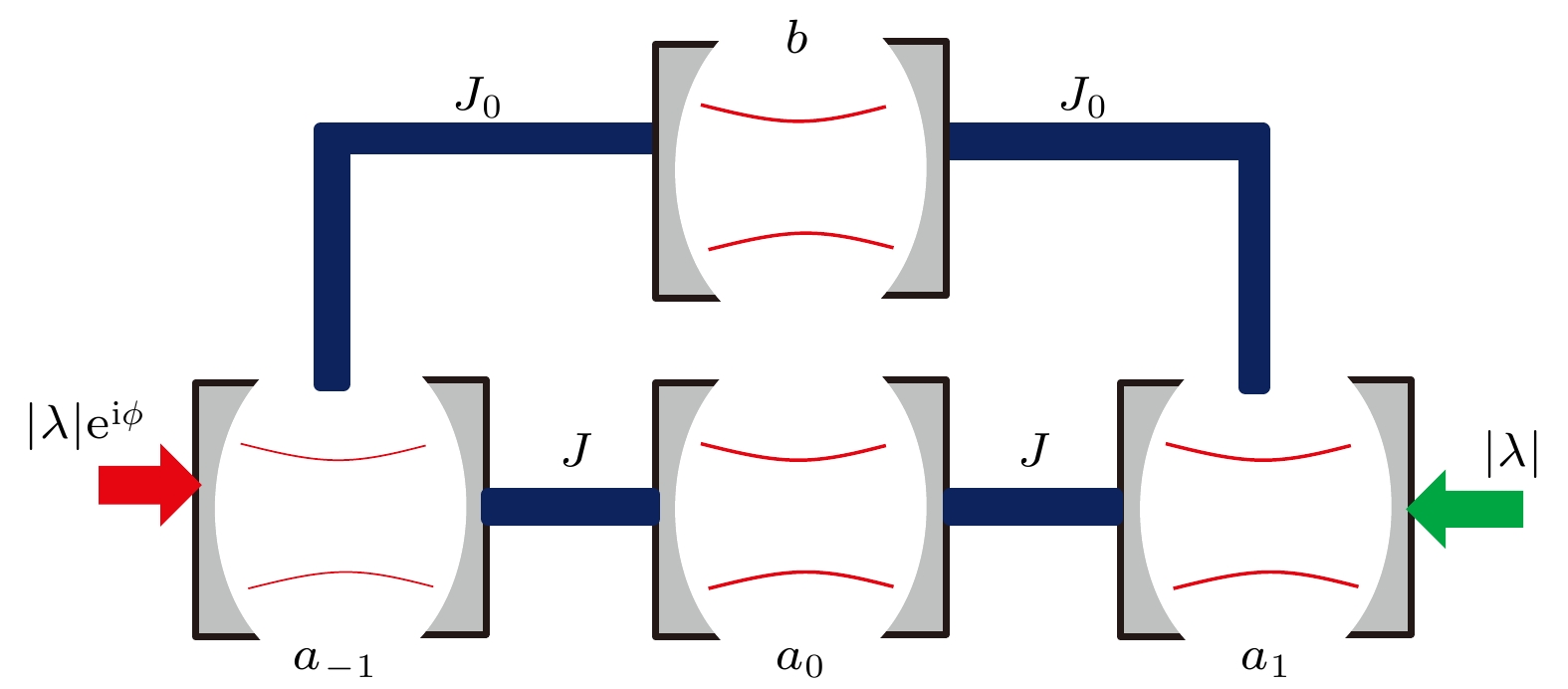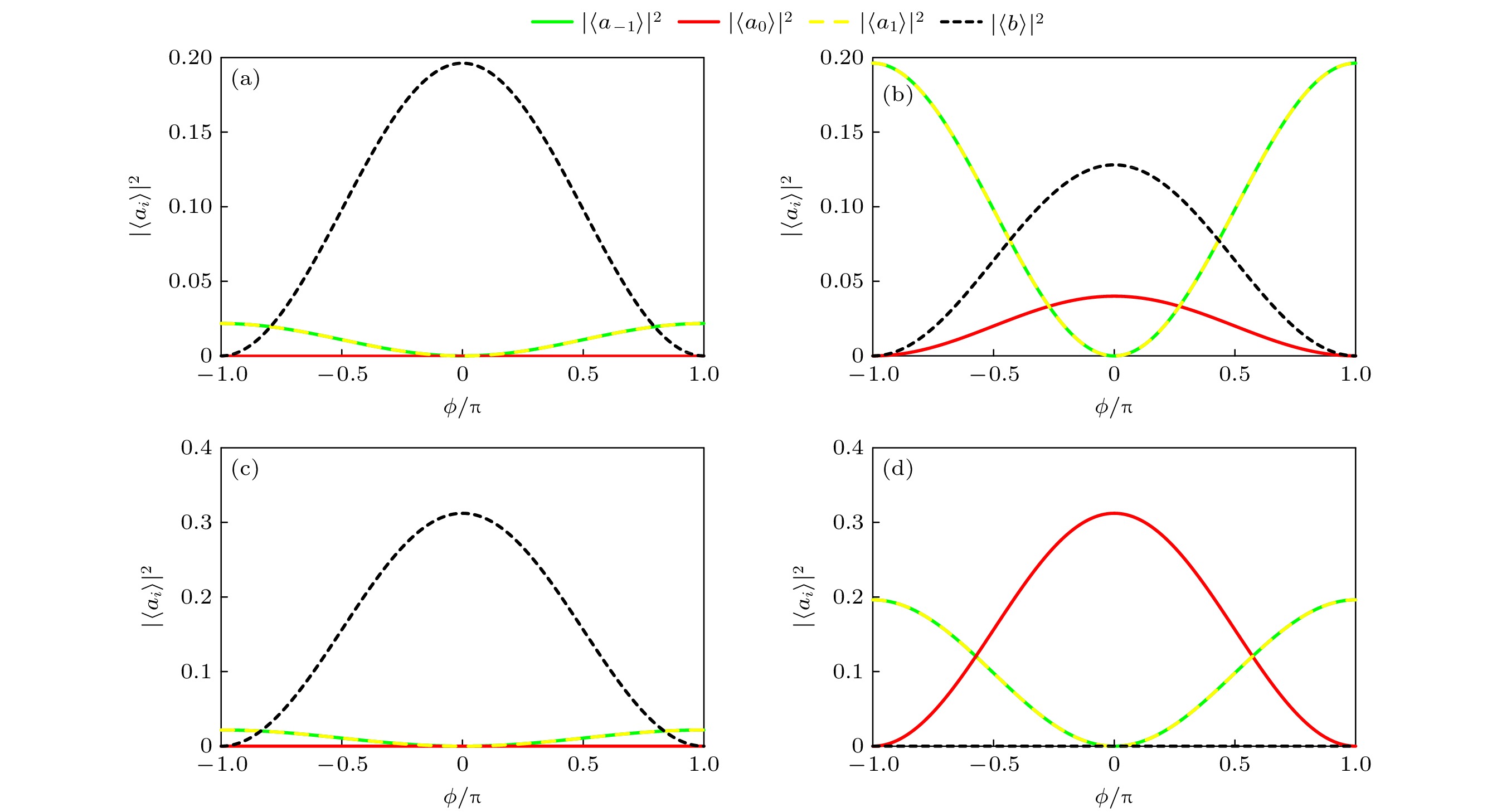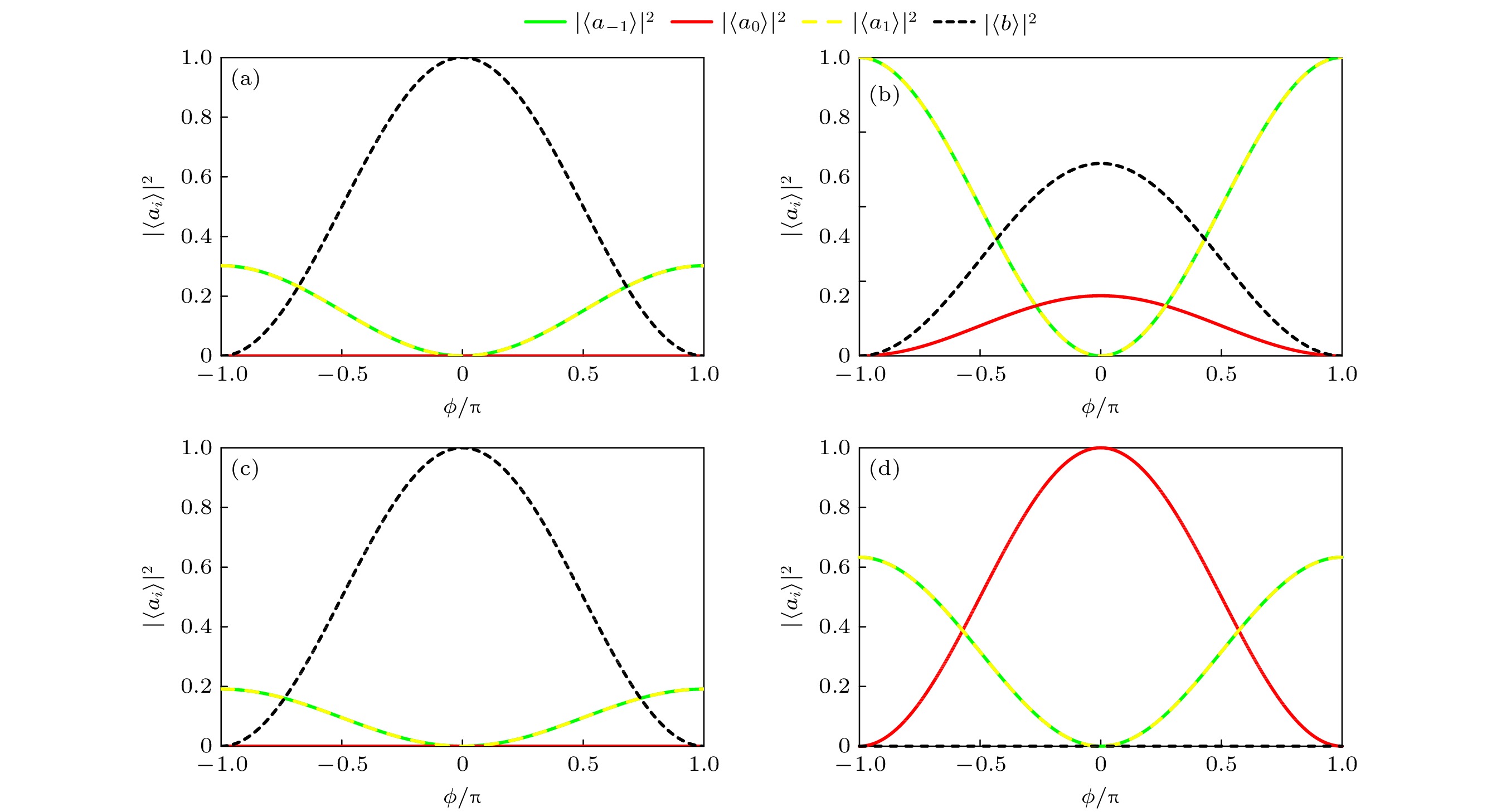-
随着巨原子研究的展开, 量子干涉效应的应用逐步广泛. 基于量子干涉效应, 利用海森伯-郎之万方程, 研究了巨腔与波导耦合系统的相位调控, 打破了传统小原子与波导耦合体系中偶极近似的限制. 研究表明, 通过给系统外加一对相位差为
$\phi$ 的驱动, 在三腔系统中, 当系统达到稳态时, 腔阵列波导的中间腔与单模巨腔内的光子数可以实现双向屏蔽. 将研究拓展至多腔系统中时, 可在不同条件下分别实现巨腔与耦合腔阵列波导的单向和双向屏蔽. 基于量子干涉效应的光子调控, 该系统可以实现腔的光子数为0, 希望在量子器件设计和量子信息处理等领域实现新应用.In the traditional quantum optics and waveguide quantum electrodynamics, atom is usually considered as a point like dipole. However, the successful coupling between a superconducting transmon and surface acoustic wave gives birth to a giant atom, which interacts with the waveguide via more than two points. In the giant atom setup, the dipole approximation breaks down the nonlocal light-matter interaction, it brings lots of unconventional quantum effects, which are presented by the phase interference. As a simplification, the giant resonator, which supports equal energy interval, can be regarded as a linear version of the giant atom. Like the giant atom system, the giant resonator is also coupled to the resonator array waveguide via two sites. According to the quantum interference effect, we study the phase control in giant resonator and the cavities in the waveguide. For a coupled three-resonator system, we reveal the characteristics of the steady state via the Heisenberg-Langevin equations when the driving and dissipation are both present. In such a system, the steady state can be coherently controlled by adjusting the phase difference $\phi$ between the two classical driving fields. We analytically give the existence condition of dark cavity. The results show that only when the middle cavity and the giant resonator are both ideal, can one realize the flash and shielding. Furthermore, we generalize the above study in three resonator system to the multiple cavity system to investigate the photonic flash and shielding. We find that when the number of the middle resonators is$4n+1\, (n\in {Z})$ , the bidirectional photonic shielding occurs, that is, the giant resonator can shield the middle resonators in the waveguide and vice versa. On the contrary, when there are$4n+3$ middle resonators in the giant resonator regime, only the directional photonic shielding happens, that is, the giant resonator can shield the waveguide, but the waveguide cannot shield the giant resonator.The above interesting photonic flash and shielding comes from the quantum interference effect. That is, the driving field injects the photons into the waveguide, and the photons propagate in different directions. In the overlapped regime, the photon carrying different phase undergoes destructive interference and acts as a dark resonator. We hope that the interference based photonic control scheme can be applied to the field of quantum device designing. -
Keywords:
- single mode giant resonator /
- coupled resonator array /
- dark resonator shielding /
- phase control
[1] Leibfried D, Blatt R, Monroe C, Wineland D 2003 Rev. Mod. Phys. 75 281
 Google Scholar
Google Scholar
[2] Haroche S 2013 Rev. Mod. Phys. 85 1083
 Google Scholar
Google Scholar
[3] You J Q, Nori F 2011 Nature 474 589
 Google Scholar
Google Scholar
[4] Xiang Z L, Ashhab S, You J Q, Nori F 2013 Rev. Mod. Phys. 85 623
 Google Scholar
Google Scholar
[5] 张智明 2015 量子光学 (北京: 科学出版社) 第26—28页
Zhang Z M 2015 Quantum Optics (Beijing: Science Press) pp26–28 (in Chinese)
[6] Cai Q Y, Jia W Z 2021 Phys. Rev. A 104 033710
 Google Scholar
Google Scholar
[7] Kockum A F, Delsing P, Johansson G 2014 Phys. Rev. A 90 013837
 Google Scholar
Google Scholar
[8] Zhao W, Wang Z H 2020 Phys. Rev. A 101 053855
 Google Scholar
Google Scholar
[9] [10] Gustafsson M V, Aref T, Kockum A F, Ekström M K, Johansson G, Delsing P 2014 Science 346 207
 Google Scholar
Google Scholar
[11] Guo L Z, Grimsmo A, Kockum A F, Pletyukhov M, Johansson G 2017 Phys. Rev. A 95 053821
 Google Scholar
Google Scholar
[12] Kockum A F, Johansson G, Nori F 2018 Phys. Rev. Lett. 120 140404
 Google Scholar
Google Scholar
[13] Kannan B, Ruckriegel M J, Campbell D L, Kockum A F, Braumüller J, Kim D K, Kjaergaard M, Krantz P, Melville A, Niedzielski B M, Vepsäläinen A, Winik R, Yoder J L, Nori F, Orlando T P, Gustavsson S, Oliver W D 2020 Nature 583 775
 Google Scholar
Google Scholar
[14] Vadiraj A M, Ask A, McConkey T G, Nsanzineza I, Chang C W S, Kockum A F, Wilson C M 2021 Phys. Rev. A 103 023710
 Google Scholar
Google Scholar
[15] Zhou L, Yang S, Liu Y X, Sun C P, Nori F 2009 Phys. Rev. A 80 062109
 Google Scholar
Google Scholar
[16] Zhou L, Gong Z R, Liu Y X, Sun C P, Nori F 2008 Phys. Rev. Lett. 101 100501
 Google Scholar
Google Scholar
[17] 程木田 2011 60 117301
 Google Scholar
Google Scholar
Cheng M T 2011 Acta Phys. Sin. 60 117301
 Google Scholar
Google Scholar
[18] Witthaut D, SØrensen A S 2010 New J.Phys. 12 043052
 Google Scholar
Google Scholar
[19] Zang X F, Jiang C 2010 J. Phys. B: At. Mol. Opt. Phys. 43 065505
 Google Scholar
Google Scholar
[20] Liao J Q, Gong Z R, Zhou L, Liu Y X, Sun C P, Nori F 2010 Phys. Rev. A 81 042304
 Google Scholar
Google Scholar
[21] 石永强, 孔维龙, 吴存仁, 张文轩, 谭磊 2017 66 054204
 Google Scholar
Google Scholar
Shi Y Q, Kong W L, Wu R C, Zhang W X, Tan L 2017 Acta Phys. Sin. 66 054204
 Google Scholar
Google Scholar
[22] 海莲, 张莎, 李维银, 谭磊 2017 66 154203
 Google Scholar
Google Scholar
Hai L, Zhang S, Li W Y, Tan L 2017 Acta Phys. Sin. 66 154203
 Google Scholar
Google Scholar
[23] Shen J T, Fan S H 2009 Phys. Rev. A 79 023838
 Google Scholar
Google Scholar
[24] Qin W, Nori F 2016 Phys. Rev. A 93 032337
 Google Scholar
Google Scholar
[25] Zhou L, Yang L P, Li Y, Sun C P 2013 Phys. Rev. Lett. 111 103604
 Google Scholar
Google Scholar
[26] Du X P, Cao Q, Dang N, Tan L 2021 Eur. Phys. J. D 75 79
 Google Scholar
Google Scholar
[27] Wang Z H, Zhou L, Li Y, Sun C P 2014 Phys. Rev. A 89 053813
 Google Scholar
Google Scholar
[28] 陆赫林, 杜春光 2016 65 214204
 Google Scholar
Google Scholar
Lu H L, Du C G 2016 Acta Phys. Sin. 65 214204
 Google Scholar
Google Scholar
[29] Lei F C, Gao M, Du C G, Jing Q L, Long G L 2015 Opt. Express 23 011508
 Google Scholar
Google Scholar
[30] Yan X B, Gu K H, Fu C B, Cui C L, Wang R, Wu J H 2014 Eur. Phys. J. D 68 126
 Google Scholar
Google Scholar
[31] Yan X B, Gu K H, Fu C B, Cui C L, Wu J H 2014 Chin. Phys. B 23 114201
 Google Scholar
Google Scholar
[32] 王雅君, 王俊萍, 张文慧, 李瑞鑫, 田龙, 郑耀辉 2021 70 204202
 Google Scholar
Google Scholar
Wang Y J, Wang J P, Zhang W H, Li R X, Tian L, Zheng Y H 2021 Acta Phys. Sin. 70 204202
 Google Scholar
Google Scholar
[33] Yin Y, Chen Y, Sank D, O’Malley P J J, White T C, Barends R, Kelly J, Lucero E, Mariantoni M, Megrant A, Neill C, Vainsencher A, Wenner J, Korotkov A N, Cleland A N, Martinis J M 2013 Phys. Rev. Lett. 110 107001
 Google Scholar
Google Scholar
[34] Meher N, Sivakumar S, Panigrahi P K 2017 Sci. Rep. 7 9251
 Google Scholar
Google Scholar
[35] 熊芳, 冯晓强, 谭磊 2016 65 044205
 Google Scholar
Google Scholar
Xiong F, Feng X Q, Tan L 2016 Acta Phys. Sin. 65 044205
 Google Scholar
Google Scholar
[36] Wang H, Blencowe M P, Armour A D, Rimberg A J 2017 Phys. Rev. B 96 104503
 Google Scholar
Google Scholar
[37] Armour A D, Blencowe M P, Brahimi E, Rimberg A J 2013 Phys. Rev. Lett. 111 247001
 Google Scholar
Google Scholar
[38] Wang Z H, Xu X W, Li Y 2017 Phys. Rev. A 95 013815
 Google Scholar
Google Scholar
[39] Cui X Y, Wang Z H, Wu J H 2018 Commun. Theor. Phys. 70 215
 Google Scholar
Google Scholar
[40] 张智明 2015 量子光学 (北京: 科学出版社) 第173—177页
Zhang Z M 2015 Quantum Optics (Beijing: Science Press) pp173–177 (in Chinese)
[41] Roushan P, Neill C, Tangpanitanon J, Bastidas V M, Megrant A, Barends R, Chen Y, Chen Z, Chiaro B, Martinis J 2017 Science 358 1175
 Google Scholar
Google Scholar
[42] Ma R, Saxberg B, Owens C, Leung N, Lu Y, Simon J, Schuster D I 2019 Nature 566 51
 Google Scholar
Google Scholar
-
图 2 系统平均光子数随相位差变化图 (a)由暗腔条件所得图像,
$ \lambda=J=\varDelta=\varDelta_{0}=\varDelta_{b}=\gamma_{b}=\gamma_{0}=\gamma $ ,$J_{0}= $ $ \dfrac{1}{2\sqrt{6}}\gamma$ ; (b)$ b $ 腔为理想腔,$ \lambda=J=J_{0}=\varDelta=\varDelta_{0}=\gamma_{0}=\gamma $ ,$ \varDelta_{b}=\gamma_{b}=0 $ ; (c)$ a_{0} $ 腔与$ b $ 腔都为理想腔,$ \lambda=J=\varDelta= $ $ J_{0}=\gamma=1 $ ,$\varDelta_{0}=\gamma_{0}= $ $ 0$ ,$ \varDelta_{b}=\gamma_{b}=0 $ ; (d)$ a_{0} $ 腔为理想腔,$ \lambda=J=J_{0}=\varDelta=\varDelta_{b}=\gamma_{b}=\gamma $ ,$ \varDelta_{0}=\gamma_{0}=0 $ Fig. 2. Diagram of system average photon number versus phase difference: (a) Under the dark cavity conditions,
$ \lambda=J=\varDelta=\varDelta_{0}=\varDelta_{b}=\gamma_{b}=\gamma_{0}=\gamma $ ,$J_{0}=\dfrac{1}{2\sqrt{6}}\gamma$ ; (b) b cavity is ideal,$ \lambda=J=J_{0}=\varDelta=\varDelta_{0}=\gamma_{0}=\gamma $ ,$ \varDelta_{b}=\gamma_{b}=0 $ ; (c) b and$ a_{0} $ cavities are ideal,$ \lambda=J=\varDelta=J_{0}=\gamma=1 $ ,$ \varDelta_{0}=\gamma_{0}=0 $ ,$ \varDelta_{b}=\gamma_{b}=0 $ ; (d)$ a_{0} $ cavity is ideal,$ \lambda=J=J_{0}=\varDelta=\varDelta_{b}= $ $ \gamma_{b}=\gamma $ ,$ \varDelta_{0}=\gamma_{0}=0 $ 图 4 多腔系统平均光子数随相位差变化图 (a)
$ b $ 腔为理想腔时,$N=8,\; j=4$ ,$ J=J_{0}=\lambda=\varDelta=\gamma=1 $ ,$ \varDelta_{b}=\gamma_{b}=0 $ ,$ \varDelta_{1}=\gamma_{1}=1 $ ; (b)中间腔为理想腔时,$N=8,\; j=4$ ,$ J=J_{0}= $ $ \lambda=\varDelta=\gamma=1 $ ,$ \varDelta_{b}=\gamma_{b}=1 $ ,$ \varDelta_{1}=\gamma_{1}=0 $ ; (c)$ b $ 腔为理想腔时,$N=8,\; j=5$ ,$ J=J_{0}=\lambda=\varDelta=\gamma=1 $ ,$ \varDelta_{b}=\gamma_{b}=0 $ ,$ \varDelta_{1}=\gamma_{1}=1 $ ; (d)中间腔为理想腔时,$N=8,\; j=5$ ,$J=J_{0}=\lambda= $ $ \varDelta=\gamma=1$ ,$ \varDelta_{b}=\gamma_{b}=1 $ ,$ \varDelta_{1}=\gamma_{1}=0 $ Fig. 4. Diagram of the average photon number changing with phase difference in a multi cavities system: (a) b cavity is ideal,
$ N=8,\; j=4 $ ,$ J=J_{0}=\lambda=\varDelta=\gamma=1 $ ,$ \varDelta_{b}=\gamma_{b}=0 $ ,$ \varDelta_{1}= \gamma_{1}=1 $ ; (b) the middle cavities are ideal,$N=8,\; j=4$ ,$ J=J_{0}=\lambda=\varDelta=\gamma=1 $ ,$ \varDelta_{b}=\gamma_{b}=1 $ ,$ \varDelta_{1}=\gamma_{1}=0 $ ; (c) b cavity is ideal,$N=8,\; j=5$ ,$ J=J_{0}=\lambda=\varDelta=\gamma=1 $ ,$ \varDelta_{b}=\gamma_{b}= $ $ 0 $ ,$ \varDelta_{1}=\gamma_{1}=1 $ ; (d) the middle cavities are ideal,$N=8,\; j=5$ ,$ J=J_{0}=\lambda=\varDelta=\gamma=1 $ ,$ \varDelta_{b}=\gamma_{b}=1 $ ,$ \varDelta_{1}=\gamma_{1}=0 $ 图 5 驱动在
$ a_{\pm j} $ 腔系统平均光子数随相位差变化图 (a)$ b $ 腔为理想腔时,$N=7,\; j=2$ ,$ J=J_{0}=\lambda=\varDelta=\gamma=1 $ ,$\varDelta_{b}=\gamma_{b}= $ $ 0$ ,$ \varDelta_{1}=\gamma_{1}=1 $ ; (b)中间腔为理想腔时,$N=7,\; j=2$ ,$ J=J_{0}=\lambda=\varDelta=\gamma=1 $ ,$ \varDelta_{b}=\gamma_{b}=1 $ ,$ \varDelta_{1}=\gamma_{1}=0 $ ; (c)$ b $ 腔为理想腔时,$N=7,\; j=3$ ,$ J=J_{0}=\lambda= $ $ \varDelta=\gamma=1 $ ,$ \varDelta_{b}=\gamma_{b}=0 $ ,$ \varDelta_{1}=\gamma_{1}=1 $ ; (d)中间腔为理想腔时,$N=7,\; j=3$ ,$J= J_{0}= \lambda= $ $ \varDelta= \gamma=1$ ,$ \varDelta_{b}=\gamma_{b}=1 $ ,$ \varDelta_{1}=\gamma_{1}=0 $ Fig. 5. Diagram of the average photon number changing with phase difference when driving in the
$ a_{\pm j} $ cavities: (a) b cavity is ideal,$N=7,\; j=2$ ,$ J=J_{0}=\lambda=\varDelta=\gamma=1 $ ,$ \varDelta_{b}=\gamma_{b}=0 $ ,$ \varDelta_{1}=\gamma_{1}=1 $ ; (b) the middle cavities are ideal,$N=7,\; j=2$ ,$ J=J_{0}=\lambda=\varDelta=\gamma=1 $ ,$ \varDelta_{b}=\gamma_{b}=1 $ ,$ \varDelta_{1}=\gamma_{1}=0 $ ; (c) b cavity is ideal,$N=7,\; j=3$ ,$ J=J_{0}=\lambda=\varDelta=\gamma=1 $ ,$ \varDelta_{b}=\gamma_{b}= $ $ 0 $ ,$ \varDelta_{1}= \gamma_{1}=1 $ ; (d) the middle cavities are ideal,$N=7, \;j=3$ ,$ J=J_{0}=\lambda=\varDelta=\gamma=1 $ ,$ \varDelta_{b}=\gamma_{b}=1 $ ,$ \varDelta_{1}=\gamma_{1}=0 $ -
[1] Leibfried D, Blatt R, Monroe C, Wineland D 2003 Rev. Mod. Phys. 75 281
 Google Scholar
Google Scholar
[2] Haroche S 2013 Rev. Mod. Phys. 85 1083
 Google Scholar
Google Scholar
[3] You J Q, Nori F 2011 Nature 474 589
 Google Scholar
Google Scholar
[4] Xiang Z L, Ashhab S, You J Q, Nori F 2013 Rev. Mod. Phys. 85 623
 Google Scholar
Google Scholar
[5] 张智明 2015 量子光学 (北京: 科学出版社) 第26—28页
Zhang Z M 2015 Quantum Optics (Beijing: Science Press) pp26–28 (in Chinese)
[6] Cai Q Y, Jia W Z 2021 Phys. Rev. A 104 033710
 Google Scholar
Google Scholar
[7] Kockum A F, Delsing P, Johansson G 2014 Phys. Rev. A 90 013837
 Google Scholar
Google Scholar
[8] Zhao W, Wang Z H 2020 Phys. Rev. A 101 053855
 Google Scholar
Google Scholar
[9] [10] Gustafsson M V, Aref T, Kockum A F, Ekström M K, Johansson G, Delsing P 2014 Science 346 207
 Google Scholar
Google Scholar
[11] Guo L Z, Grimsmo A, Kockum A F, Pletyukhov M, Johansson G 2017 Phys. Rev. A 95 053821
 Google Scholar
Google Scholar
[12] Kockum A F, Johansson G, Nori F 2018 Phys. Rev. Lett. 120 140404
 Google Scholar
Google Scholar
[13] Kannan B, Ruckriegel M J, Campbell D L, Kockum A F, Braumüller J, Kim D K, Kjaergaard M, Krantz P, Melville A, Niedzielski B M, Vepsäläinen A, Winik R, Yoder J L, Nori F, Orlando T P, Gustavsson S, Oliver W D 2020 Nature 583 775
 Google Scholar
Google Scholar
[14] Vadiraj A M, Ask A, McConkey T G, Nsanzineza I, Chang C W S, Kockum A F, Wilson C M 2021 Phys. Rev. A 103 023710
 Google Scholar
Google Scholar
[15] Zhou L, Yang S, Liu Y X, Sun C P, Nori F 2009 Phys. Rev. A 80 062109
 Google Scholar
Google Scholar
[16] Zhou L, Gong Z R, Liu Y X, Sun C P, Nori F 2008 Phys. Rev. Lett. 101 100501
 Google Scholar
Google Scholar
[17] 程木田 2011 60 117301
 Google Scholar
Google Scholar
Cheng M T 2011 Acta Phys. Sin. 60 117301
 Google Scholar
Google Scholar
[18] Witthaut D, SØrensen A S 2010 New J.Phys. 12 043052
 Google Scholar
Google Scholar
[19] Zang X F, Jiang C 2010 J. Phys. B: At. Mol. Opt. Phys. 43 065505
 Google Scholar
Google Scholar
[20] Liao J Q, Gong Z R, Zhou L, Liu Y X, Sun C P, Nori F 2010 Phys. Rev. A 81 042304
 Google Scholar
Google Scholar
[21] 石永强, 孔维龙, 吴存仁, 张文轩, 谭磊 2017 66 054204
 Google Scholar
Google Scholar
Shi Y Q, Kong W L, Wu R C, Zhang W X, Tan L 2017 Acta Phys. Sin. 66 054204
 Google Scholar
Google Scholar
[22] 海莲, 张莎, 李维银, 谭磊 2017 66 154203
 Google Scholar
Google Scholar
Hai L, Zhang S, Li W Y, Tan L 2017 Acta Phys. Sin. 66 154203
 Google Scholar
Google Scholar
[23] Shen J T, Fan S H 2009 Phys. Rev. A 79 023838
 Google Scholar
Google Scholar
[24] Qin W, Nori F 2016 Phys. Rev. A 93 032337
 Google Scholar
Google Scholar
[25] Zhou L, Yang L P, Li Y, Sun C P 2013 Phys. Rev. Lett. 111 103604
 Google Scholar
Google Scholar
[26] Du X P, Cao Q, Dang N, Tan L 2021 Eur. Phys. J. D 75 79
 Google Scholar
Google Scholar
[27] Wang Z H, Zhou L, Li Y, Sun C P 2014 Phys. Rev. A 89 053813
 Google Scholar
Google Scholar
[28] 陆赫林, 杜春光 2016 65 214204
 Google Scholar
Google Scholar
Lu H L, Du C G 2016 Acta Phys. Sin. 65 214204
 Google Scholar
Google Scholar
[29] Lei F C, Gao M, Du C G, Jing Q L, Long G L 2015 Opt. Express 23 011508
 Google Scholar
Google Scholar
[30] Yan X B, Gu K H, Fu C B, Cui C L, Wang R, Wu J H 2014 Eur. Phys. J. D 68 126
 Google Scholar
Google Scholar
[31] Yan X B, Gu K H, Fu C B, Cui C L, Wu J H 2014 Chin. Phys. B 23 114201
 Google Scholar
Google Scholar
[32] 王雅君, 王俊萍, 张文慧, 李瑞鑫, 田龙, 郑耀辉 2021 70 204202
 Google Scholar
Google Scholar
Wang Y J, Wang J P, Zhang W H, Li R X, Tian L, Zheng Y H 2021 Acta Phys. Sin. 70 204202
 Google Scholar
Google Scholar
[33] Yin Y, Chen Y, Sank D, O’Malley P J J, White T C, Barends R, Kelly J, Lucero E, Mariantoni M, Megrant A, Neill C, Vainsencher A, Wenner J, Korotkov A N, Cleland A N, Martinis J M 2013 Phys. Rev. Lett. 110 107001
 Google Scholar
Google Scholar
[34] Meher N, Sivakumar S, Panigrahi P K 2017 Sci. Rep. 7 9251
 Google Scholar
Google Scholar
[35] 熊芳, 冯晓强, 谭磊 2016 65 044205
 Google Scholar
Google Scholar
Xiong F, Feng X Q, Tan L 2016 Acta Phys. Sin. 65 044205
 Google Scholar
Google Scholar
[36] Wang H, Blencowe M P, Armour A D, Rimberg A J 2017 Phys. Rev. B 96 104503
 Google Scholar
Google Scholar
[37] Armour A D, Blencowe M P, Brahimi E, Rimberg A J 2013 Phys. Rev. Lett. 111 247001
 Google Scholar
Google Scholar
[38] Wang Z H, Xu X W, Li Y 2017 Phys. Rev. A 95 013815
 Google Scholar
Google Scholar
[39] Cui X Y, Wang Z H, Wu J H 2018 Commun. Theor. Phys. 70 215
 Google Scholar
Google Scholar
[40] 张智明 2015 量子光学 (北京: 科学出版社) 第173—177页
Zhang Z M 2015 Quantum Optics (Beijing: Science Press) pp173–177 (in Chinese)
[41] Roushan P, Neill C, Tangpanitanon J, Bastidas V M, Megrant A, Barends R, Chen Y, Chen Z, Chiaro B, Martinis J 2017 Science 358 1175
 Google Scholar
Google Scholar
[42] Ma R, Saxberg B, Owens C, Leung N, Lu Y, Simon J, Schuster D I 2019 Nature 566 51
 Google Scholar
Google Scholar
计量
- 文章访问数: 4020
- PDF下载量: 110
- 被引次数: 0


















 下载:
下载:













































































































